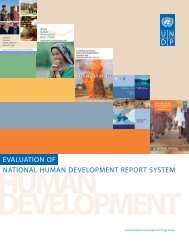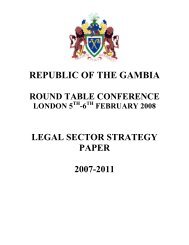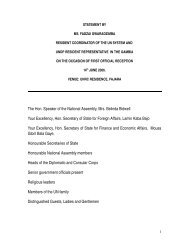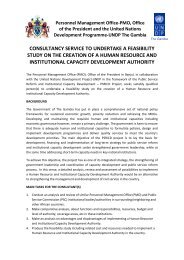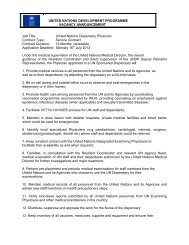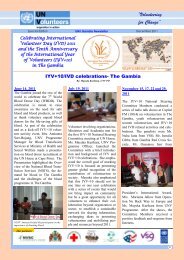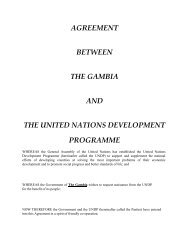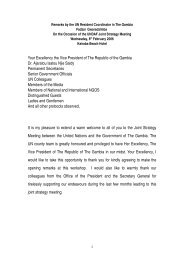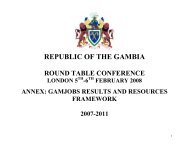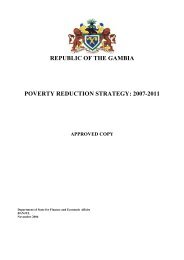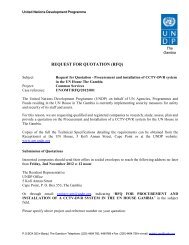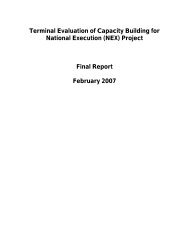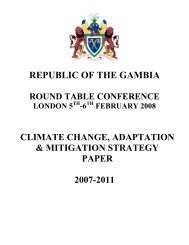Introduction - UNDP The Gambia
Introduction - UNDP The Gambia
Introduction - UNDP The Gambia
You also want an ePaper? Increase the reach of your titles
YUMPU automatically turns print PDFs into web optimized ePapers that Google loves.
________________________________________________________________________________________________________________________<br />
<strong>The</strong> local institutional structures such as the<br />
alkaloship and other traditional forms of<br />
decision-making bodies do not allow the<br />
effective involvement of women and the<br />
youth as strategic decision-makers. Yet these<br />
are the critical actors whose support and<br />
contributions are sought when it comes to<br />
realising development objectives at the<br />
community level.<br />
At the same time, the gender representation of<br />
VDCs within the mainstream development<br />
framework at the community level is not<br />
impressive. <strong>The</strong> absence of women in the<br />
decision-making process will make the<br />
outcomes of the development plans not<br />
gender responsive and will thus contribute to<br />
the non-attainment the MDGs.<br />
However, mainstreaming gender into all the<br />
existing structures should be a priority to<br />
strategically place gender issues within them<br />
in order to achieve the targets. This is<br />
necessary because both women and men are<br />
critical actors in achieving the targets of the<br />
MDGs. Thus gender equality is viewed not<br />
only as a goal in its own right but also as a<br />
key factor in enhancing developmenteradicating<br />
poverty, and stamping out<br />
violence against women, ensuring education<br />
for all, improving maternal health, reducing<br />
child mortality and combating HIV/AIDS.<br />
Gender equality in such structures will<br />
address the gaps, as they are interrelated.<br />
It is observed that the MDGs cannot be fully<br />
attained while women and girls, men and<br />
boys do not enjoy equal rights, treatment and<br />
access to resources in a climate of freedom<br />
from discrimination (Commonwealth POA<br />
for Gender Equality, 2005-2015). Table 13<br />
shows the gender gaps in area councils in <strong>The</strong><br />
<strong>Gambia</strong>. This pattern seems to be the same in<br />
all the other local structures.<br />
Table 13: Comparison between women and men area councillors in <strong>The</strong> <strong>Gambia</strong><br />
Council No of males No of females Total % of females<br />
Banjul City 8 4 12 33<br />
KMC 20 1 21 4.7<br />
Mansakonko 19 1 20 5<br />
Kuntaur 11 2 13 15<br />
Brikama 29 2 31 6<br />
Janjangbureh 15 1 16 6<br />
Kerewan 19 1 20 5<br />
Basse 15 2 17 12<br />
Total 136 14 150 9<br />
Source: <strong>UNDP</strong> Governance and Gender in Development, <strong>The</strong> <strong>Gambia</strong>, Medium-Term Plan, 2005-2009<br />
5.4 Conclusions and Recommendations<br />
This chapter critically examined the <strong>Gambia</strong>n<br />
traditional structures that can play important<br />
roles in the development landscape and, in<br />
particular, the rural communities. It looked at<br />
the structures by describing their roles in the<br />
past and present, and what they can be in the<br />
current development of <strong>The</strong> <strong>Gambia</strong> in<br />
ensuring sustainable development.<br />
It also looked at the challenges and<br />
opportunities facing these structures, and<br />
provided suggestions on how they could be<br />
empowered to respond to the roles and<br />
responsibilities they are expected to play to<br />
ensure the implementation of development<br />
activities in <strong>The</strong> <strong>Gambia</strong>.<br />
It is clear from the above analysis that <strong>The</strong><br />
<strong>Gambia</strong> should embrace a development<br />
paradigm that will allow for citizen<br />
participation to effect the necessary change<br />
for its population. It will also have to provide<br />
an enabling environment to allow the citizens<br />
to take charge of their own development. <strong>The</strong><br />
majority of Africa’s population lives in the<br />
________________________________________________________________________________________________<br />
Building Capacity for the Attainment of the Millennium Development Goals in <strong>The</strong> <strong>Gambia</strong> National Human Development Report 2005<br />
61




